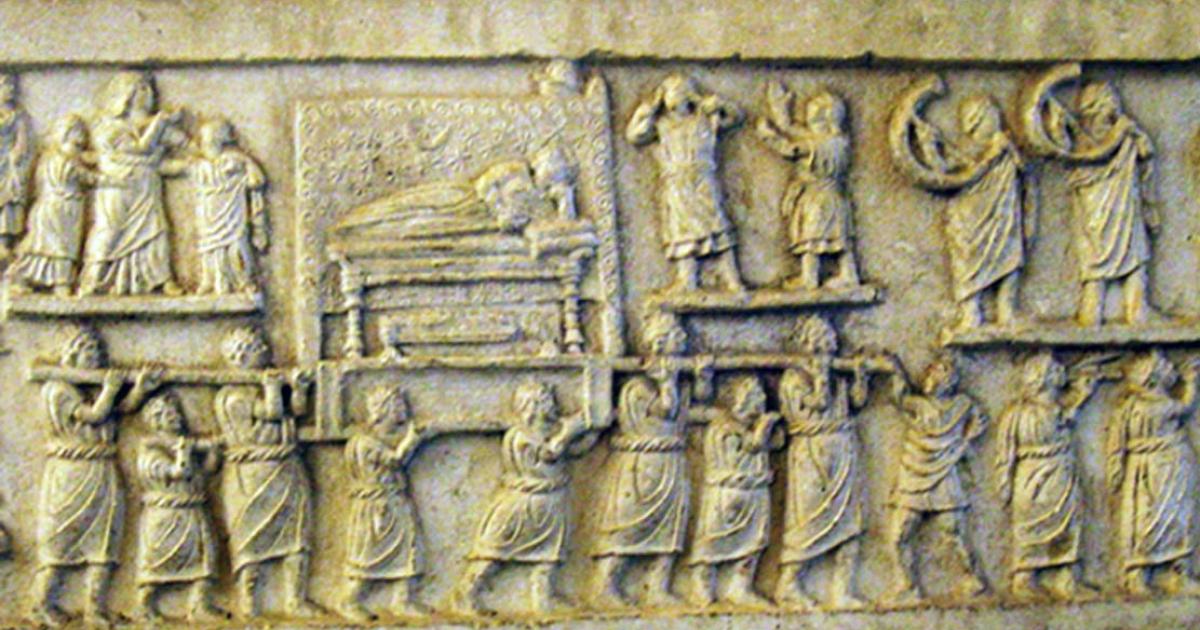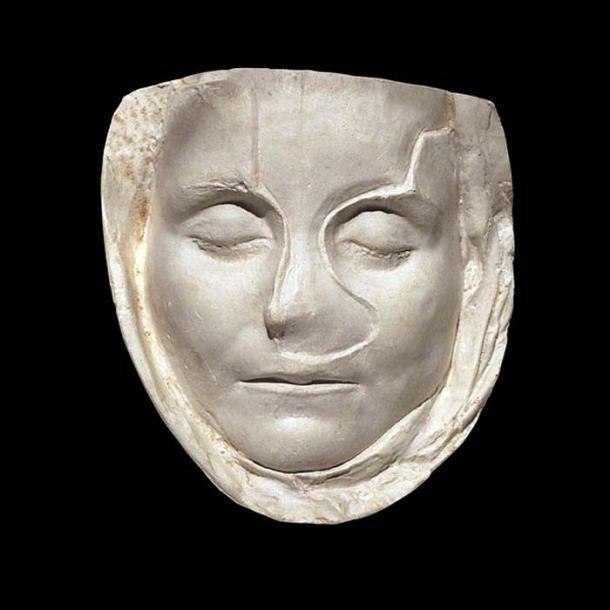
Mimes, Paid Grievers, and Masks: The Insane Theatrics of Ancient Roman Funerals
Two thousand years ago, funerals weren’t the quiet, somber affairs we have today. They were loud, boisterous shows that started with a massive procession of people parading down the streets, pounding away at musical instruments and trying to get everyone around to stop and watch the show.
They’ve been called “carnivalesque” – they were big productions full of life, joy, and laughter. Hired actors would walk behind the musicians of the funeral processions and put on shows that, today, might sound ridiculous.
But for the Romans, death wasn’t just a time for mourning. It was a time to celebrate the person who once lived – and they pulled out all of the stops.
Hired Professional Mourners Were Paid To Grieve
Roman funerals started with a procession. A mob of people would hit the streets, carrying the body off the necropolis to be cremated, and it was important to any self-respecting Roman to make that mob as big as possible. They wanted a big show – something that let everyone know just how loved they were.
The wealthier a Roman was, the better the funeral procession would be. A poor family might only be able to afford to pay someone to give his best whistle into a flute while their loved ones carried off their body, but if you were rich, you didn’t need anyone to love you. You could pay people to be sad.
- The Grand Funeral of Thai King Bhumibol Adulyadej and Intricate Buddhist Funerary Rites
- The Toraja people and the most complex funeral rituals in the world
- The 10th century chronicle of the violent, orgiastic funeral of a Viking chieftain
Professional mourners could be hired to follow your funeral procession down the street. Women who’d never met you would walk with your dead body, loudly crying and putting on insane theatrics of grief to make your death look good.

Amiternum funerary procession relief. (Lady Erin/CC BY NC ND 2.0)
These shows of grief got so over-the-top that the Romans had to make a law barring hired mourners from tearing out their own hair and scratching their own faces to keep things at least a little bit dignified.
A Funerary Mime Would Imitate The Deceased
Behind the hired mourners would be a professional actor, sitting atop a chariot, dressed in the dead man’s clothes. He’d follow the procession down the street, waving at the people on the side on the road, wearing a mask of the deceased’s face.
They were called “funerary mimes”, and they were a sure sign of wealth. Getting a good mime who could really pass himself off as you when you died was expensive. The best mimes would follow their clients around throughout their entire lives, watching their gestures and favorite turns of phrases so that they could put on the best imitation possible when their client died.

Mould of a child's face, found in 1874. The epitaph (ref CIL 13, 02108) reads: "To the manes and in the memory of Claudia Victoria, dead at the age of 10 years old, one month and eleven days; Claudia Severina, her mother, raised this tomb to her beloved daughter when she was still alive, to herself and dedicated it under the ascia." (Rama/CC BY SA 2.0)
Those imitations weren’t always flattering. The best mimes were comedians – when Emperor Vespasian died, his funerary mime poked fun at the dead emperor’s tendency to be a little too frugal. During the procession, he asked how much this whole funeral was costing him, and, when he heard someone say, “Ten million sesterces”, called back: “Give me a hundred thousand and fling me into the Tiber!”
Still, having a funerary mime was all the rage. All the kings had them – we know for sure that Julius Caesar and Emperor Julian hired funerary mimes, and it’s highly likely that the other Romans emperors used them as well. It was a sign of success to have a hired actor imitate you after you died; proof that people cared enough to know what kind of man you were.
People Dressed Up As Dead Ancestors Would Attend The Funeral
There’d be more than just one person in your funeral procession wearing a costume. Not only would there be a hired mime imitating the deceased, but there’d be an entire procession of people dressed up as everybody in his family.
The funeral director would track down people who looked like the deceased’s ancestors and would fit them with masks of his ancestor’s faces. They were called “imagines”, and they’d be dressed up in the clothes those people wore in life, following behind the funerary mime, greeting the crowd.

Reconstruction of a Roman funeral. Collection of Gallo-Romeins Museum, Tongeren, Belgium. (Carole Raddato/CC BY SA 2.0)
It would probably look a little strange to us today to see a group of actors dressed up as dead people walking down the streets, but to the Romans, it was a way of showing off just how important you really were. The actors would dress in clothes that showed off the highest rank the deceased’s family had reached in life. It was a way of saying “I wasn’t just important – my whole family is a big deal.”
They’d be there through the whole funeral. When the family made it to the necropolis, where the real funeral would be held, there’d be a whole row of ivory chairs waiting for the actors. Throughout the funeral, there was a whole line of people sitting in watching with the masks of dead people covering their faces.

The so-called "Togatus Barberini": a Roman senator holding effigies of deceased ancestors; one is part-supported by a herm. Marble, late 1st century BC; head (not belonging): middle 1st century BC. (Public Domain)
Putting The Dead To Rest
Getting to the funeral was an incredible and ridiculous show, full of actors, musicians, and jokes. It was more like a party than a funeral; in fact, the procession was often bigger and livelier than at Roman weddings.
But the funeral was still a moment of respect; a time to put the dead to rest. Once they reached the necropolis, things went quiet.
- Archaeologists Discover Ancient Irish Funeral Practices Involved ‘Deconstruction’ of the Body
- Turtles May Have Been Feasted On as Part of Funeral Rites at Ancient Turkey Site
- Traditional Funerary Rites Provide a Glimpse at Mystery Neolithic Vietnamese Culture

Tomb of the Scipios, in use from the 3rd century BC to the 1st century AD. (Pippo-b/CC BY SA 3.0)
The family would watch and wait while the loved one they’d lost was burned. Burning the body, they believed, would send the spirit out into the world and, until the ashes were put in a funerary urn, the spirit of the departed would be there in the room with them. They would deliver a eulogy, say their last words to the departed, and get what they believed was one last chance to speak to the dead.
Then there’d be a feast and the celebrations would pick up once more. The mask the funerary mime had worn would be kept in the family’s home. It would be on display during religious holidays and saved for the next funeral, when it was its turn to join the throng of dead ancestors in the processions.

Grave relief showing the deceased and his widow in a funeral feast where they are depicted in a godlike manner. Roman marble work, 1st century AD. (Public Domain)
It’s strange to us today – but it was a celebration of life unlike any other. The dead would never be forgotten. For generations to come, the faces of your ancestors would be there in your home, watching over you while you were alive and walking with you as you crossed over to the other side.
Top Image: Amiternum funerary procession relief. (Lady Erin/CC BY NC ND 2.0)
By Mark Oliver
References
Bonafanta, Larissa. “Classical and Barbarian.” The Barbarians of Ancient Europe: Realities and Interactions. Cambridge University Press, 2011.
https://books.google.com/books?id=fS4XmwEEsRkC&printsec=frontcover#v=onepage&q&f=false
Polybius. The Histories. Harvard University Press, 2015. https://www.loebclassics.com/view/polybius-histories/2010/pb_LCL138.431.xml?readMode=recto
Suetonius. “The Life of Vespasian.” The Lives of the Twelve Caesars. Loeb Classical Library, 1914. http://penelope.uchicago.edu/Thayer/E/Roman/Texts/Suetonius/12Caesars/Vespasian*.html
Sumi, Geoffrey. “Impersonating the Dead: Mimes at Roman Funerals.” American Journal of Philology. The John Hopkins University Press, 2002. http://westlake-library.wikispaces.com/file/view/Impersonating+the+Dead+-+Mimes+at+Roman+Funerals.pdf
















Comments
You forgot the gladiator's games. Initially, gladiators fought only on funerals to honor the deceased, and never to death.